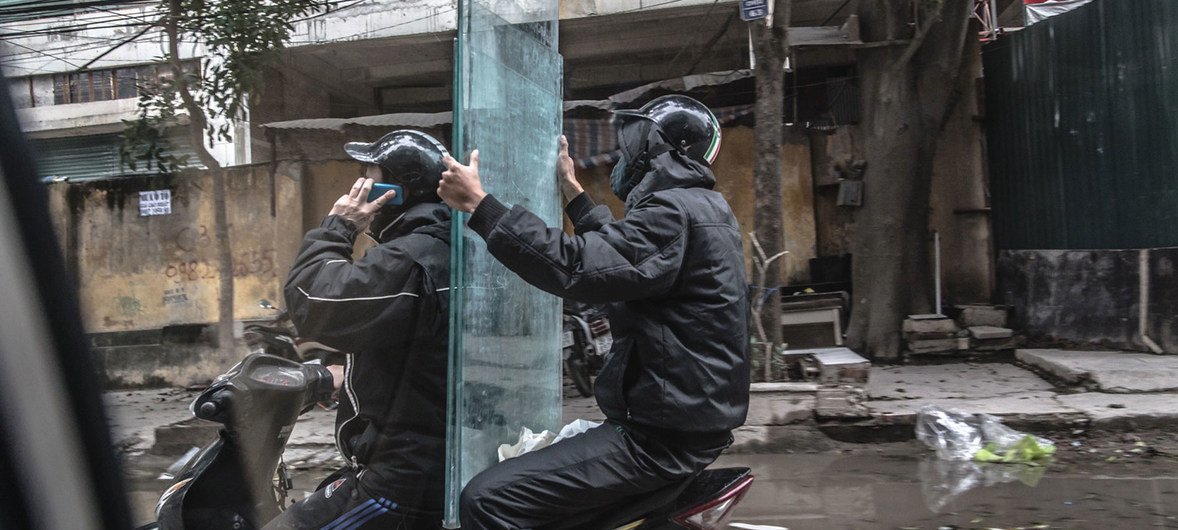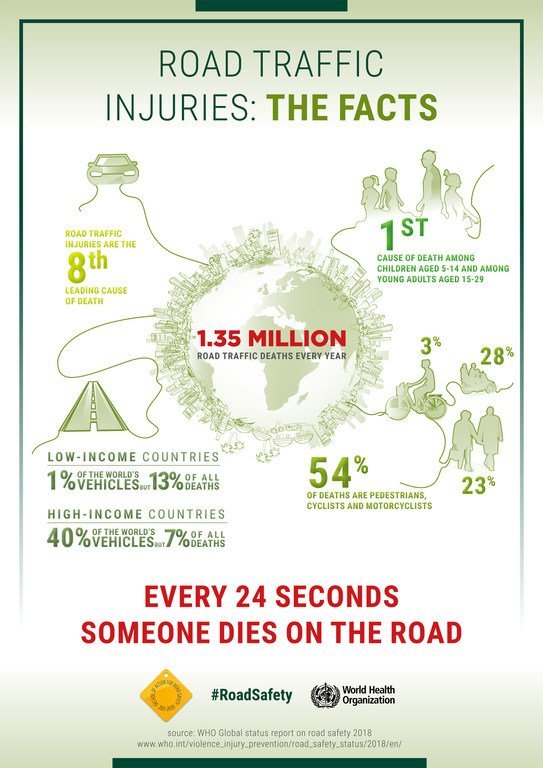‘Diversity is a form of wealth, not a factor of division,’ UNESCO chief says ahead of International Day for Tolerance
UNDP Ukraine/Oleksandr Ratushnyak
Children in Ukraine play with an SDG poster illustrating children from different races around the world.
At a time when extremism and fanaticism are too often unleashed, when “the venom of hatred” continues to poison a part of humanity, “tolerance has never been more vital a virtue”, the United Nations cultural agency’s chief has said in her message on the International Day for Tolerance.
“Tolerance is more than standing idly by or remaining insensitive to differences between men and women, cultures and beliefs”, Audrey Azoulay, the Director-General of the UN Educational, Scientific and Cultural Organization (UNESCO) said, but instead a “state of mind, an awareness and a requirement.”
In 1996, the UN General Assembly invited Member States to observe the Day each year on 16 November to, among other things, foster mutual understanding among cultures and peoples. The 2019 edition of the Day will be marked this Saturday.
Ms. Azoulay stressed that tolerance is “to realize that cultural diversity is a form of wealth, not a factor of division”.
“It is to perceive that each culture, beyond immediate or apparent differences, is a constituent part of universality and speaks the common language of humanity.”
Quoting former UN Secretary-General Kofi Annan, she said that tolerance is “a virtue that makes peace possible”.
Combatting intolerance
Since its foundation, UNESCO has aimed to “build peace by combating the intolerance that still too often tears our societies apart, and by relentlessly fighting all forms of racism and discrimination”, the agency chief maintained.
Ms. Azoulay cited the words of former Director-General Federico Mayor: “UNESCO bears and echoes the message of tolerance, true to its mission of being ‘the conscience of the United Nations’”.
In conclusion, Ms. Azoulay invited everyone to share UNESCO’s message of tolerance and peace.
Fighting intolerance requires
- Law: Governments are responsible for enforcing human rights laws and banning and punishing hate crimes and discrimination against minorities.
- Education: Greater efforts must be made to teach children about tolerance, human rights and other ways of life, both at home and in school.
- Information access: Policies must be developed to generate and promote press freedom and press pluralism, to allow the public to differentiate between facts and opinions.
- Individual awareness: People should become aware of the link between their behavior and the vicious cycle of mistrust and violence in society, by asking yourself if you stereotype people, reject those who are different from you and/or blame you problems on 'them'?
- Local solutions: Tools of nonviolent action include discrediting hateful propaganda, co-organizing groups to confront problems and establishing grassroot networks to demonstrate solidarity with victims of intolerance.
NEWS TRACKER: PAST STORIES ON THIS ISSUE
7 November 2019
Since nobody is born to hate, intolerance can be prevented and unlearned, the UN Secretary-General said on Thursday, in a speech underlining his continued fight to stamp out antisemitism, racism and other forms of hatred.
26 June 2019
The “multi-headed monster” of intolerance, has created a visible and violent “tsunami of hatred” that is gathering speed across the world, said Secretary-General António Guterres on Wednesday.
ShareThis Copy and Paste
Skip to main content ‘Diversity is a form of wealth, not a factor of division,’ UNESCO chief says ahead of International Day for Tolerance UNDP Ukraine/Oleksandr Ratushnyak Children in Ukraine play with an SDG poster illustrating children from different races around the world. 15 November 2019 Human Rights At a time when extremism and fanaticism are too often unleashed, when “the venom of hatred” continues to poison a part of humanity, “tolerance has never been more vital a virtue”, the United Nations cultural agency’s chief has said in her message on the International Day for Tolerance. “Tolerance is more than standing idly by or remaining insensitive to differences between men and women, cultures and beliefs”, Audrey Azoulay, the Director-General of the UN Educational, Scientific and Cultural Organization (UNESCO) said, but instead a “state of mind, an awareness and a requirement.” In 1996, the UN General Assembly invited Member States to observe the Day each year on 16 November to, among other things, foster mutual understanding among cultures and peoples. The 2019 edition of the Day will be marked this Saturday. Ms. Azoulay stressed that tolerance is “to realize that cultural diversity is a form of wealth, not a factor of division”. “It is to perceive that each culture, beyond immediate or apparent differences, is a constituent part of universality and speaks the common language of humanity.” Quoting former UN Secretary-General Kofi Annan, she said that tolerance is “a virtue that makes peace possible”. Combatting intolerance Since its foundation, UNESCO has aimed to “build peace by combating the intolerance that still too often tears our societies apart, and by relentlessly fighting all forms of racism and discrimination”, the agency chief maintained. Ms. Azoulay cited the words of former Director-General Federico Mayor: “UNESCO bears and echoes the message of tolerance, true to its mission of being ‘the conscience of the United Nations’”. In conclusion, Ms. Azoulay invited everyone to share UNESCO’s message of tolerance and peace. Fighting intolerance requires Law: Governments are responsible for enforcing human rights laws and banning and punishing hate crimes and discrimination against minorities. Education: Greater efforts must be made to teach children about tolerance, human rights and other ways of life, both at home and in school. Information access: Policies must be developed to generate and promote press freedom and press pluralism, to allow the public to differentiate between facts and opinions. Individual awareness: People should become aware of the link between their behavior and the vicious cycle of mistrust and violence in society, by asking yourself if you stereotype people, reject those who are different from you and/or blame you problems on 'them'? Local solutions: Tools of nonviolent action include discrediting hateful propaganda, co-organizing groups to confront problems and establishing grassroot networks to demonstrate solidarity with victims of intolerance. ♦ Receive daily updates directly in your inbox - Subscribe here to a topic. ♦ Download the UN News app for your iOS or Android devices. UN INTERNATIONAL DAY FOR TOLERANCE|INTOLERANCE LISTEN TO UN RADIO INTERVIEWS6'6" 'YouTubers’ putting a stop to intolerance on International D... RELATED STORIES Tackle ‘tsunami of hatred’ across the world urges Guterres, to counter anti-Semitism, racism and intolerance With message for freedom, jazz beat heard around the world – UNESCO Engaging ‘head and mind’, key for effective learning, says UNESCO chief on Literacy Day NEWS TRACKER: PAST STORIES ON THIS ISSUE Antisemitism, intolerance, can be unlearned, Guterres tells New York commemoration 7 November 2019Culture and Education Since nobody is born to hate, intolerance can be prevented and unlearned, the UN Secretary-General said on Thursday, in a speech underlining his continued fight to stamp out antisemitism, racism and other forms of hatred. Tackle ‘tsunami of hatred’ across the world urges Guterres, to counter anti-Semitism, racism and intolerance 26 June 2019Human Rights The “multi-headed monster” of intolerance, has created a visible and violent “tsunami of hatred” that is gathering speed across the world, said Secretary-General António Guterres on Wednesday. RESOURCES Navigate the News Information for Broadcasters UN System Links Media Alert UN Journal Meetings Coverage Audiovisual Library SECRETARY-GENERAL All Statements Official Travels Press Encounters SG Twitter SPOKESPERSON'S OFFICE Latest Statements Briefing Highlights Briefing Transcripts Notes to Correspondents FIND US UN News App Facebook Twitter YouTube RSS Contact UN News UNITED NATIONS A-Z Site IndexContactCopyrightFAQFraud AlertPrivacy NoticeTerms of Use Skip to main content ‘Diversity is a form of wealth, not a factor of division,’ UNESCO chief says ahead of International Day for Tolerance UNDP Ukraine/Oleksandr Ratushnyak Children in Ukraine play with an SDG poster illustrating children from different races around the world. 15 November 2019 Human Rights At a time when extremism and fanaticism are too often unleashed, when “the venom of hatred” continues to poison a part of humanity, “tolerance has never been more vital a virtue”, the United Nations cultural agency’s chief has said in her message on the International Day for Tolerance. “Tolerance is more than standing idly by or remaining insensitive to differences between men and women, cultures and beliefs”, Audrey Azoulay, the Director-General of the UN Educational, Scientific and Cultural Organization (UNESCO) said, but instead a “state of mind, an awareness and a requirement.” In 1996, the UN General Assembly invited Member States to observe the Day each year on 16 November to, among other things, foster mutual understanding among cultures and peoples. The 2019 edition of the Day will be marked this Saturday. Ms. Azoulay stressed that tolerance is “to realize that cultural diversity is a form of wealth, not a factor of division”. “It is to perceive that each culture, beyond immediate or apparent differences, is a constituent part of universality and speaks the common language of humanity.” Quoting former UN Secretary-General Kofi Annan, she said that tolerance is “a virtue that makes peace possible”. Combatting intolerance Since its foundation, UNESCO has aimed to “build peace by combating the intolerance that still too often tears our societies apart, and by relentlessly fighting all forms of racism and discrimination”, the agency chief maintained. Ms. Azoulay cited the words of former Director-General Federico Mayor: “UNESCO bears and echoes the message of tolerance, true to its mission of being ‘the conscience of the United Nations’”. In conclusion, Ms. Azoulay invited everyone to share UNESCO’s message of tolerance and peace. Fighting intolerance requires Law: Governments are responsible for enforcing human rights laws and banning and punishing hate crimes and discrimination against minorities. Education: Greater efforts must be made to teach children about tolerance, human rights and other ways of life, both at home and in school. Information access: Policies must be developed to generate and promote press freedom and press pluralism, to allow the public to differentiate between facts and opinions. Individual awareness: People should become aware of the link between their behavior and the vicious cycle of mistrust and violence in society, by asking yourself if you stereotype people, reject those who are different from you and/or blame you problems on 'them'? Local solutions: Tools of nonviolent action include discrediting hateful propaganda, co-organizing groups to confront problems and establishing grassroot networks to demonstrate solidarity with victims of intolerance. ♦ Receive daily updates directly in your inbox - Subscribe here to a topic. ♦ Download the UN News app for your iOS or Android devices. UN INTERNATIONAL DAY FOR TOLERANCE|INTOLERANCE LISTEN TO UN RADIO INTERVIEWS6'6" 'YouTubers’ putting a stop to intolerance on International D... RELATED STORIES Tackle ‘tsunami of hatred’ across the world urges Guterres, to counter anti-Semitism, racism and intolerance With message for freedom, jazz beat heard around the world – UNESCO Engaging ‘head and mind’, key for effective learning, says UNESCO chief on Literacy Day NEWS TRACKER: PAST STORIES ON THIS ISSUE Antisemitism, intolerance, can be unlearned, Guterres tells New York commemoration 7 November 2019Culture and Education Since nobody is born to hate, intolerance can be prevented and unlearned, the UN Secretary-General said on Thursday, in a speech underlining his continued fight to stamp out antisemitism, racism and other forms of hatred. Tackle ‘tsunami of hatred’ across the world urges Guterres, to counter anti-Semitism, racism and intolerance 26 June 2019Human Rights The “multi-headed monster” of intolerance, has created a visible and violent “tsunami of hatred” that is gathering speed across the world, said Secretary-General António Guterres on Wednesday. RESOURCES Navigate the News Information for Broadcasters UN System Links Media Alert UN Journal Meetings Coverage Audiovisual Library SECRETARY-GENERAL All Statements Official Travels Press Encounters SG Twitter SPOKESPERSON'S OFFICE Latest Statements Briefing Highlights Briefing Transcripts Notes to Correspondents FIND US UN News App Facebook Twitter YouTube RSS Contact UN News UNITED NATIONS A-Z Site IndexContactCopyrightFAQFraud AlertPrivacy NoticeTerms of UseShareThis Copy and Paste











